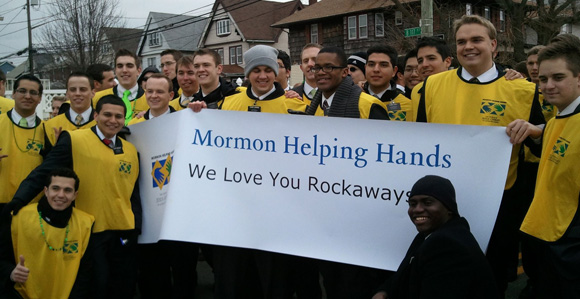Missionaries Help Community Recover
Contributed By By Sarah Jane Weaver, Church News staff writer

Donning the yellow Mormon Helping Hands vests worn in the weeks after Hurricane Sandy, missionaries from the New York New York South Mission march in the Queens County St. Patrick’s Day parade on March 2 to cheers from the crowd.
Article Highlights
- Missionaries from the New York New York South Mission marched in the 38th annual Queens County St. Patrick’s Day Parade on March 2 for providing thousands of hours of service after Hurricane Sandy.
- After Hurricane Sandy, 28,000 Latter-day Saint volunteers provided 300,000 hours of service.
- Because he doesn’t want there to be any confusion as to why the Church helped after the disaster, the local mission president said missionaries will not proselytize in the area in the near future.
“It is really the Church of Jesus Christ in action. … Mankind was hurting, and we needed to help them.” —President Kevin E. Calderwood of the New York New York South Mission
Related Links
NEW YORK CITY
After working thousands of hours in homes devastated by Hurricane Sandy, missionaries from the New York New York South Mission marched in the 38th annual Queens County St. Patrick’s Day Parade on March 2.
The crowds in the Rockaways—a community still recovering from the disaster—went wild; their “little yellow army of happiness” had returned to a hero’s welcome.
Donning the yellow Mormon Helping Hands vests they wore in the weeks after the disaster, the missionaries marched along the parade route carrying a huge sign: “We Love You Rockaways.”
Crowds on the parade route hurriedly made their own signs: “We love the Mormon Helping Hands.”
“We have made some very good friends,” said President Kevin E. Calderwood of the New York New York South Mission, noting that during the parade the missionaries were cheered and given a standing ovation.
Hurricane Sandy, which devastated the coastlines of New York and New Jersey in late October, is one of the largest storms to ever hit the United States. In response, the Church provided 11 truckloads of relief supplies (approximately 400,000 pounds), including food, water, blankets, hygiene kits, generators, pumps, tarps, cleaning supplies, and fuel, according to a Church welfare report.
More important, 28,000 Latter-day Saint volunteers provided 300,000 hours of service, said Ferren Squires, area welfare manager. Much of that work was fueled by the local missionaries, who worked every day for nine weeks and helped coordinate the work of other Church members in the northeast United States who came on the weekends to provide additional assistance.
President Calderwood said the missionaries had an emergency plan that required them to “be safe, then serve.” As a result, while the “wind was still blowing” after the storm, missionaries headed into the Rockaways. They helped members and their neighbors, first responders, and then the community.
“I learned the missionaries are very good at tearing things apart,” said President Calderwood. “We would laugh and pray with the people. The missionaries went in with smiles on their faces. They were happy to be there. They didn’t waste any time.”
Knee deep in water and muck, the missionaries formed bucket brigades and hauled furniture, carpeting, and dry wall out of homes. “This went on for weeks and weeks.”
Often people would ask why so many young people would give so much. “We were doing it because we love them,” President Calderwood said. “It is really the Church of Jesus Christ in action. … Mankind was hurting, and we needed to help them.”
Sister Shianne Allen, from Los Angeles, California, said they weren’t just cleaning the homes of people, but “it was the homes of people we really grew to love.”
Elder Joshua Munday of Kent, England, said to see people suffering was really heartbreaking.
But “in the dark and gloomy basements you saw a light in yourself—and in the families you were serving—that is rarely found. This was an opportunity to show the world what we believe in and what we stand for.”
President Calderwood said that because he doesn’t want there to be any confusion as to why the Church helped after the disaster, missionaries will not proselytize in the area in the near future.
Elder Jeffery E. Olson, an Area Seventy in the North America Northeast Area, coordinated the Church’s response to Sandy—even though his own home was flooded and without power for 13 days.
He said it was “absolutely amazing to watch” the Church and its members in action after the storm. “People really worked full-time for weeks,” he said of the Church’s response to the disaster.
Elder Olson said it was obvious during the recent parade that the people the Church served in the Rockaways were appreciative of the efforts.
“They cheered. They were so gracious about expressing gratitude for the missionaries,” he said. He added that one crowd yelled to the missionaries as they passed, “Mormons, Mormons, you are the true heroes.”
Elder Ben Ferry of Corinne, Utah, said marching in the parade was a unique experience. “As missionaries, we don’t get applauded very often,” he said.
Elder Munday agreed. “For the first time, maybe in history, the Mormons were applauded as they walked down the street.”
